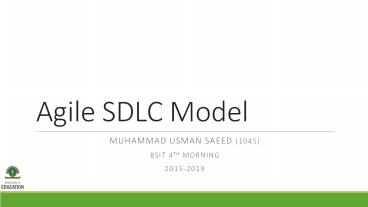Agile Model PowerPoint PPT Presentation
Title: Agile Model
1
Agile SDLC Model
- Muhammad Usman Saeed (1045)
- BSIT 4th Morning
- 2015-2019
2
Contents
- What is Agile
- Agile Development Life Cycle
- Working of Agile
- Advantages
- Disadvantages
- References
3
Agile Model
- Agile is a Software Development Methodology
- It means ability to move quickly and easily
and responding swiftly to change - It is a multi-iterative lifecycle.
- Develop and deliver software incrementally from
the start of the project, instead of trying to
deliver it all at once near the end.
4
Agile (Cont.)
- One Iteration is typically 1 to 4 weeks
- The development is aligned with the changing
business needs - It works by breaking projects down into little
bits of user functionality called user stories,
prioritizing them, and then continuously
delivering them in short two week cycles
called iterations.
5
Agile Life Cycle
6
How does it work?
7
Make a List
- Sitting down with the customers
- Make a list of features they would like to see
in their software. - We call these things user stories
- They become the To Do list for project.
8
User Stories
9
Size Things up
- Size user stories using Agile estimation
techniques - Coming up with a guess as to how long each user
story will take.
10
Size Things up
- Size user stories using Agile estimation
techniques - Coming up with a guess as to how long each user
story will take.
11
Time Estimation
- Relatively sizing means dont worry about
exactly how big a story is. - Worry more how this storys size compares to
others.
12
Set Priorities
- Like any other lists, there always seems to be
more to do than time allows. - Ask the customer to prioritize their list
- Get the most important stuff done first, and
save the least important for last.
13
Start Project
- Start delivering some value.
- Start at the top. Work your way to the bottom.
- Building, iterating, and getting feedback from
your customer as you go.
14
Update Plans
- Then, as you and your customer starting
delivering, one of two things is going to happen.
You'll discover - You're going fast enough. All is good.
- Or, You have too much to do and not enough time.
- At this point you have two choices. You can
either a) do less and cut scope (recommended). Or
you can b) push out the date and ask for more
money.
15
Advantages
- Customer satisfaction through early and
continuous software delivery. - Requirements can be changed during development
process. - Frequently delivering of working software.
- Support, trust and motive the customer.
- Enable face to face interaction.
- Regular interaction with software to make it
more effective.
16
Disadvantages
- In case of some software deliverables,
especially the large ones, it is difficult to
assess the effort required at the beginning of
the software development life cycle. - There is lack of emphasis on necessary designing
and documentation. - The project can easily get taken off track if
the customer representative is not clear what
final outcome that they want. - Only senior programmers are capable of taking
the kind of decisions required during the
development process.
17
References
- https//www.tutorialspoint.com/sdlc/sdlc_agile_mo
del.html - http//istqbexamcertification.com/what-is-agile-m
odel-advantages-disadvantages-and-when-to-use-it/ - http//www.agilemodeling.com/essays/introductionT
oAM.html - https//en.wikipedia.org/wiki/Agile_software_deve
lopment

